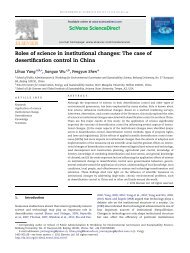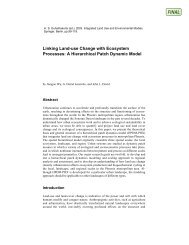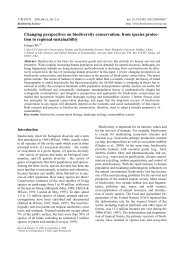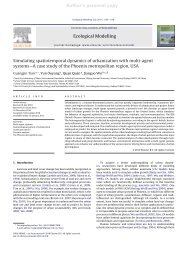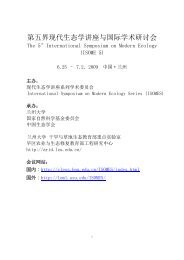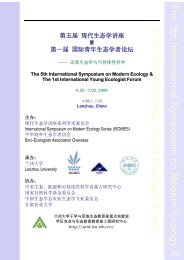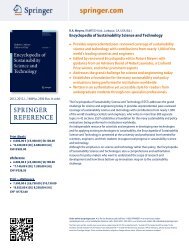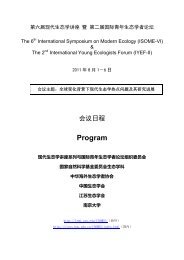Download PDF - Springer
Download PDF - Springer
Download PDF - Springer
You also want an ePaper? Increase the reach of your titles
YUMPU automatically turns print PDFs into web optimized ePapers that Google loves.
222 BERLING-WOLFF AND WU<br />
effort of experimentation with different grain sizes (for multi-scale analysis), simulation start<br />
dates, and rule modifications. Several supporting utilities were also developed to facilitate<br />
data preparation and the new methods of calibration and analysis (see below). Grid images<br />
for input were created by ArcView and results were written out and stored in an ArcView<br />
compatible format for ease of display.<br />
Model parameterization and calibration<br />
The extent of the study area is delimited by a 68.5 km × 88.75 km boundary centered on<br />
the Phoenix metropolitan area, as defined by CAP-LTER. The major data input used for<br />
parameterizing PHX-UGM included land-use maps for 1975 and 1995 with four classes: undeveloped<br />
desert, urbanized areas, recreation areas, and agriculture (Knowles-Yanez et al.,<br />
1999), maps of land ownership and 1978 road data layers obtained from the CAP-LTER<br />
database, and topographic information derived from the United States Geological Survey<br />
(USGS) digital elevation models (DEMs). All vector-based data files were converted into<br />
raster format using ArcView. An important reason for choosing the land use data of 1975 and<br />
1995 was that the rate of urbanization during this time period was extraordinary: urban land<br />
use increased from 7% in 1975 to 18% of the total area in 1995 (Knowles-Yanez et al., 1999).<br />
It is impossible to directly validate the model projections of future growth because we<br />
simply do not have the data. However, we can calibrate the model so that it describes,<br />
as accurately as possible, what has already happened. Then, based on past trends, we<br />
can project likely future patterns. This retrospective approach has inherent problems for<br />
studying complex self-organizing systems whose future, by definition, can not be predicted<br />
by its past (Wu and Marceau, 2002). However, we believe that this traditional modeling<br />
approach in combination with scenario-based analysis can still provide valuable insights<br />
about how urban landscapes may develop. Before such exploratory attempts, however,<br />
the model must be able to reproduce the known system behavior reasonably well. This<br />
often involves model calibration (or tuning), the process in which certain model parameters<br />
and constants are adjusted so that the agreement between model output and observations<br />
is improved. As described above, several variables control the probability for a cell to<br />
be urbanized (e.g. Diffusion Coefficient, Breed Coefficient, Spread Coefficient and Slope<br />
Resistance) and the distance along a road that urban development may take place (e.g. Road<br />
Gravity). Additionally, PHX-UGM has two new variables NEI HOOD and NEI RQMT<br />
that define the “neighborhood” and the number of neighbors that must be urbanized to<br />
consider urbanizing a new cell. The goal of calibrating the model is to find the combination<br />
of settings that yield the most satisfactory results.<br />
We followed the two calibration phases built in HILT: a visual version for general pattern<br />
comparison and a more computationally efficient batch version for quantitative evaluation.<br />
The visual phase is used to establish meaningful ranges of values as well as to verify that<br />
growth is proceeding within reasonable bounds, while the second phase involves a variety of<br />
statistical measures. Based on preliminary sensitivity analysis, we selected only a small set<br />
of parameters for model calibration, including Diffusion, Breed, Spread, and Road Gravity.<br />
There were 1024 different combinations run in total. The performance was evaluated using<br />
the Lee-Sallee value as described in Clarke et al. (1997).




